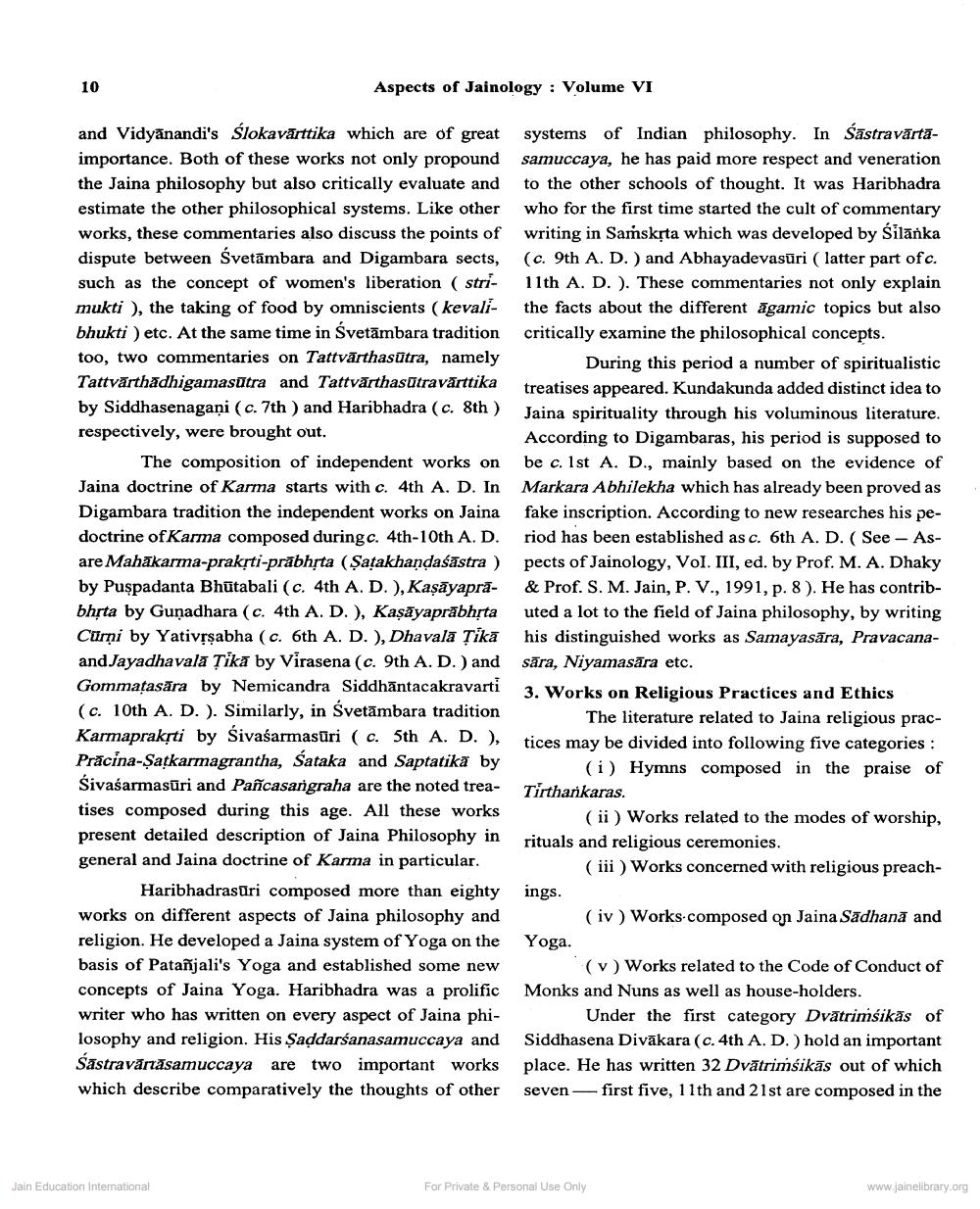________________
10
Aspects of Jainology: Volume VI
and Vidyanandi's Ślokavārttika which are of great importance. Both of these works not only propound the Jaina philosophy but also critically evaluate and estimate the other philosophical systems. Like other works, these commentaries also discuss the points of dispute between Śvetambara and Digambara sects, such as the concept of women's liberation ( strimukti ), the taking of food by omniscients (kevalibhukti) etc. At the same time in Svetambara tradition too, two commentaries on Tattvārthasūtra, namely Tattvärthadhigamasutra and Tattvärthasūtravārttika by Siddhasenagani (c. 7th) and Haribhadra (c. 8th) respectively, were brought out.
systems of Indian philosophy. In Śāstravārtāsamuccaya, he has paid more respect and veneration to the other schools of thought. It was Haribhadra who for the first time started the cult of commentary writing in Samskṛta which was developed by Śilanka (c. 9th A. D.) and Abhayadevasūri ( latter part of c. 11th A. D. ). These commentaries not only explain the facts about the different agamic topics but also critically examine the philosophical concepts.
Jain Education International
During this period a number of spiritualistic treatises appeared. Kundakunda added distinct idea to Jaina spirituality through his voluminous literature. According to Digambaras, his period is supposed to be c. 1st A. D., mainly based on the evidence of Markara Abhilekha which has already been proved as fake inscription. According to new researches his period has been established as c. 6th A. D. (See - Aspects of Jainology, Vol. III, ed. by Prof. M. A. Dhaky & Prof. S. M. Jain, P. V., 1991, p. 8). He has contributed a lot to the field of Jaina philosophy, by writing his distinguished works as Samayasāra, Pravacanasāra, Niyamasāra etc.
The composition of independent works on Jaina doctrine of Karma starts with c. 4th A. D. In Digambara tradition the independent works on Jaina doctrine of Karma composed during c. 4th-10th A. D. are Mahakarma-prakṛti-prabhṛta (Ṣatakhaṇḍaśāstra) by Puspadanta Bhūtabali (c. 4th A. D.), Kaṣāyaprabhrta by Gunadhara (c. 4th A. D.), Kasayaprabhṛta Curni by Yativṛṣabha (c. 6th A. D.), Dhavalā Țikā and Jayadhavala Ṭikā by Virasena (c. 9th A. D.) and Gommaṭasara by Nemicandra Siddhantacakravarti 3. Works on Religious Practices and Ethics (c. 10th A. D.). Similarly, in Svetambara tradition The literature related to Jaina religious pracKarmaprakṛti by Śivaśarmasuri (c. 5th A. D.), tices may be divided into following five categories: Pracina-Satkarmagrantha, Śataka and Saptatika by Śivaśarmasuri and Pañcasangraha are the noted treatises composed during this age. All these works present detailed description of Jaina Philosophy in general and Jaina doctrine of Karma in particular.
(i) Hymns composed in the praise of Tirthankaras.
(ii) Works related to the modes of worship, rituals and religious ceremonies.
(iii) Works concerned with religious preach
(iv) Works-composed on Jaina Sādhanā and
Yoga.
Haribhadrasuri composed more than eighty ings. works on different aspects of Jaina philosophy and religion. He developed a Jaina system of Yoga on the basis of Patanjali's Yoga and established some new concepts of Jaina Yoga. Haribhadra was a prolific writer who has written on every aspect of Jaina philosophy and religion. His Saddarśanasamuccaya and Śāstravārtāsamuccaya are two important works which describe comparatively the thoughts of other
(v) Works related to the Code of Conduct of Monks and Nuns as well as house-holders.
Under the first category Dvatrimśikās of Siddhasena Divakara (c. 4th A. D.) hold an important place. He has written 32 Dvātrimśikās out of which first five, 11th and 21st are composed in the
seven
For Private & Personal Use Only
www.jainelibrary.org




